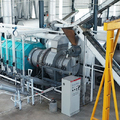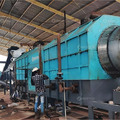In the realm of sustainable packaging, egg tray molding making has emerged as a commendable solution, addressing both environmental concerns and the need for efficient, protective packaging. Egg tray molding, also known as pulp molding or pulp egg tray machine, involves the use of recycled paper to create biodegradable and recyclable trays for egg packaging. This innovative process not only repurposes waste material but also offers a practical and eco-friendly alternative to traditional plastic packaging. In this comprehensive exploration, we will delve into the intricacies of egg tray molding making, its environmental benefits, the technology behind it, and its potential to revolutionize sustainable packaging solutions.

Understanding Egg Tray Molding Making
Raw Material: Recycled Paper: The primary raw material used in egg tray molding making is recycled paper. This can include newspapers, cardboard, and other paper waste. The recycling process involves breaking down the paper into a pulp, creating a versatile and environmentally friendly material for molding.
Pulp Molding Process: The egg tray molding process typically follows a sequence of steps. Firstly, recycled paper is mixed with water to create a pulp. This pulp is then molded into the desired shape using specially designed molds. The molded pulp is subsequently dried and can be further processed for enhanced durability and quality.
Molded Tray Design: The molds used in egg tray molding making are designed to accommodate the specific needs of egg packaging. The trays are typically molded in a configuration that securely cradles individual eggs, providing protection during transportation and storage.
Environmental Benefits of Egg Tray Molding
Utilization of Recycled Materials: Egg tray molding relies on recycled paper, diverting it from landfills and giving it a new purpose. This reduces the demand for virgin materials and minimizes the environmental impact associated with paper production.
Biodegradability: The use of recycled paper in egg tray molding ensures that the resulting trays are biodegradable. After their intended use, the trays can decompose naturally, contributing to reduced environmental pollution and waste accumulation.
Reduced Carbon Footprint: Compared to plastic or foam packaging, egg tray molding has a lower carbon footprint. The manufacturing process is energy-efficient, and the use of recycled materials further decreases the overall environmental impact.
Circular Economy: Egg tray molding exemplifies the principles of a circular economy by repurposing waste materials into valuable products. This closed-loop approach aligns with sustainability goals, promoting responsible resource use.
The Technology Behind Egg Tray Molding Making
Pulping System: The first step in egg tray molding making involves creating a pulp from recycled paper. This is achieved through a pulping system, where the paper is broken down into fibers using water and sometimes chemical additives. The result is a slurry-like mixture ready for molding.
Molding Equipment: Specialized molding equipment is used to shape the pulp into egg trays. Molds are designed to accommodate the desired tray configuration, and they can vary based on the number of eggs each tray is intended to hold.
Drying Process: Once molded, the trays go through a drying process to remove moisture and achieve the desired strength. Various drying methods may be employed, including air drying or using industrial drying ovens.
Finishing and Packaging: After drying, the egg trays may undergo additional processing steps for quality improvement. This can include trimming excess material, adding labeling or branding, and packaging for distribution.
Applications Beyond Egg Packaging
Fruit and Produce Packaging: The versatility of egg tray molding extends beyond egg packaging to other delicate items like fruits and produce. The molded trays can provide a protective and sustainable solution for packaging fruits, preventing bruising and damage during transit.
Electronics Packaging: The cushioning properties of molded pulp make it suitable for packaging delicate electronic components. Molded trays can be customized to securely hold and protect electronic devices during shipping.
Wine Bottle Packaging: Molded pulp wine trays offer an eco-friendly alternative to traditional packaging materials. These trays can securely cradle wine bottles, providing protection against breakage and reducing the environmental impact of packaging.
Medical Supplies Packaging: The shock-absorbing qualities of molded pulp make it suitable for packaging medical supplies and devices. Customized trays can be designed to securely hold and protect fragile medical equipment during transportation.
Challenges and Considerations
Despite the numerous advantages, egg tray molding making faces certain challenges:
Water Usage: The pulping process involves water, and while efforts are made to recycle and minimize water consumption, this aspect of egg tray molding may pose challenges in regions facing water scarcity.
Material Consistency: The quality and consistency of recycled paper feedstock can impact the final product. Variations in paper quality may require adjustments in the molding process to maintain uniform tray characteristics.
Transportation Costs: The lightweight nature of egg trays can result in high transportation costs per unit. Innovations in tray design or localized production may help address this challenge.
Consumer Awareness: Raising awareness among consumers about the benefits of choosing products packaged in molded pulp trays is essential for widespread adoption. Education about the environmental impact of packaging choices can drive demand for sustainable options.

Innovations and Future Trends
Advanced Molded Tray Designs: Ongoing research focuses on optimizing tray designs for enhanced functionality and sustainability. Innovations include trays with improved shock absorption properties, reduced material usage, and increased customization options.
Alternative Fiber Sources: Exploration of alternative fiber sources, such as agricultural residues or non-wood fibers, could diversify the feedstock used in egg tray molding making. This not only expands the range of materials but also addresses concerns about deforestation.
Advanced Drying Technologies: Innovations in drying technologies aim to improve the efficiency and reduce the energy consumption of the drying process. Techniques like infrared drying or microwave drying may offer more sustainable alternatives.
Integration of Smart Packaging: The integration of smart packaging technologies, such as RFID tags or QR codes, could enhance the traceability and information-sharing capabilities of molded pulp trays. This provides additional value to consumers and stakeholders in the supply chain.
Conclusion
Egg tray molding making stands at the forefront of sustainable packaging solutions, demonstrating the potential to reshape the way we approach packaging across various industries. With a commitment to utilizing recycled materials, reducing environmental impact, and fostering a circular economy, this innovative process aligns with global efforts to transition towards more sustainable practices. As technology continues to evolve and consumer awareness grows, egg tray molding making has the potential to set new standards for responsible and eco-friendly packaging, contributing to a greener and more sustainable future.





